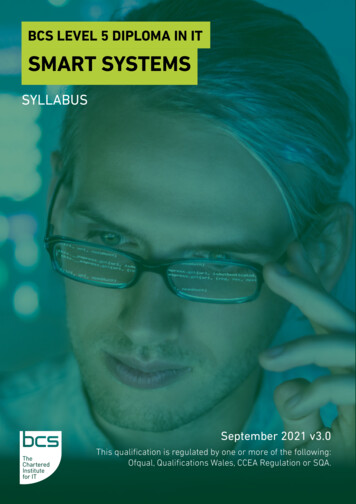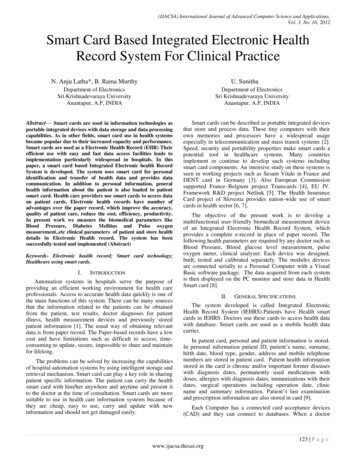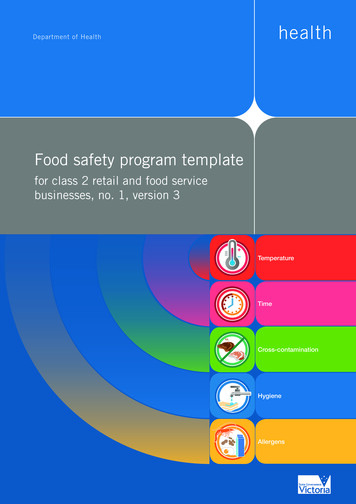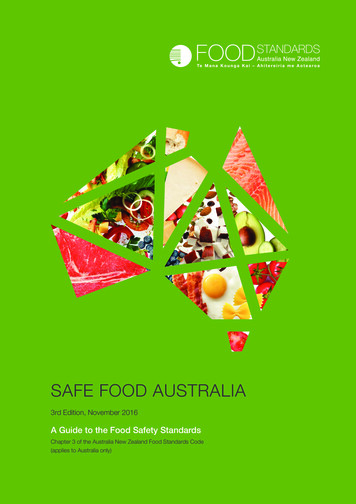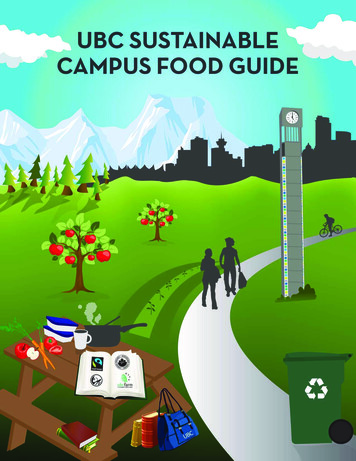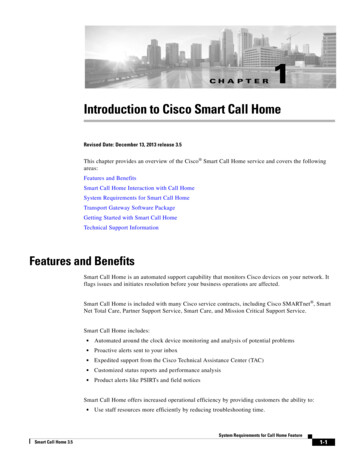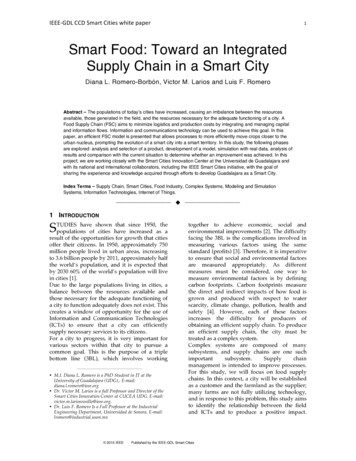
Transcription
IEEE- ‐GDLCCDSmartCitieswhitepaper1Smart Food: Toward an IntegratedSupply Chain in a Smart CityDiana L. Romero-Borbón, Victor M. Larios and Luis F. RomeroAbstract – The populations of today’s cities have increased, causing an imbalance between the resourcesavailable, those generated in the field, and the resources necessary for the adequate functioning of a city. AFood Supply Chain (FSC) aims to minimize logistics and production costs by integrating and managing capitaland information flows. Information and communications technology can be used to achieve this goal. In thispaper, an efficient FSC model is presented that allows processes to more efficiently move crops closer to theurban nucleus, prompting the evolution of a smart city into a smart territory. In this study, the following phasesare explored: analysis and selection of a product, development of a model, simulation with real data, analysis ofresults and comparison with the current situation to determine whether an improvement was achieved. In thisproject, we are working closely with the Smart Cities Innovation Center at the Universidad de Guadalajara andwith its national and international collaborators, including the IEEE Smart Cities initiative, with the goal ofsharing the experience and knowledge acquired through efforts to develop Guadalajara as a Smart City.Index Terms – Supply Chain, Smart Cities, Food Industry, Complex Systems, Modeling and SimulationSystems, Information Technologies, Internet of Things.—————————— u ——————————1 INTRODUCTIONhave shown that since 1950, theSTUDIESpopulations of cities have increased as aresult of the opportunities for growth that citiesoffer their citizens. In 1950, approximately 750million people lived in urban areas, increasingto 3.6 billion people by 2011, approximately halfthe world’s population, and it is expected thatby 2030 60% of the world’s population will livein cities [1].Due to the large populations living in cities, abalance between the resources available andthose necessary for the adequate functioning ofa city to function adequately does not exist. Thiscreates a window of opportunity for the use ofInformation and Communication Technologies(ICTs) to ensure that a city can efficientlysupply necessary services to its citizens.For a city to progress, it is very important forvarious sectors within that city to pursue acommon goal. This is the purpose of a triplebottom line (3BL), which involves ��— M.I. Diana L. Romero is a PhD Student in IT at theUniversity of Guadalajara (UDG),. E-mail:diana.l.romero@ieee.org Dr. Victor M. Larios is a full Professor and Director of theSmart Cities Innovation Center at CUCEA UDG. E-mail:victor.m.lariosrosillo@ieee.org. Dr. Luis F. Romero Is a Full Professor at the IndustrialEngineering Department, Universidad de Sonora. E-mail:lromero@industrial.uson.mx 2015 IEEEtogether to achieve economic, social andenvironmental improvements [2]. The difficultyfacing the 3BL is the complications involved inmeasuring various factors using the samestandard (profits) [3]. Therefore, it is imperativeto ensure that social and environmental factorsare measured appropriately. As differentmeasures must be considered, one way tomeasure environmental factors is by definingcarbon footprints. Carbon footprints measurethe direct and indirect impacts of how food isgrown and produced with respect to waterscarcity, climate change, pollution, health andsafety [4]. However, each of these factorsincreases the difficulty for producers ofobtaining an efficient supply chain. To producean efficient supply chain, the city must betreated as a complex system.Complex systems are composed of manysubsystems, and supply chains are one suchimportantsubsystem.Supplychainmanagement is intended to improve processes.For this study, we will focus on food supplychains. In this context, a city will be establishedas a customer and the farmland as the supplier;many farms are not fully utilizing technology,and in response to this problem, this study aimsto identify the relationship between the fieldand ICTs and to produce a positive impact.Published by the IEEE-GDL Smart Cities
IEEE- ‐GDLCCDSmartCitieswhitepaper2that aspires to be smart through the use ofWith the idea of moving beyond a Smart Citytoward the creation of a Smart Territory, thisstudy will combine Smart Cities and FoodSupply Chains.Through the Smart Cities Innovation Center atCUCEA Universidad de Guadalajara (UDG),several organizations have expressed interest inthis project. Figure 1 shows some of theseorganizations, divided by their sectors andareas of societal impact.technology. This smart food supply chain willinvolve the design of a model that improves , a primary goal of this project is toreduce food waste and carbon footprintsthrough improvements to supply chain logisticsusing information technologies, as well as thecreation of a model for simulation. As a firststep, this workwill focus onblueberryproduction near Guadalajara city as a model ofan actual supply chain and consumer marketsin the city. A computerized model will assistour search for optimizations using simulationsand analytics. Furthermore, we will adapt thissimulation model to other food productionFig. 1. Beneficiaries from the Project and its SocialImpact.This project is part of the IEEE Smart Citiesinitiative, which aims to support smart foodsystems related to the Guadalajara Smart City.This project will also collaborate with the MITMedia Lab City Farm project in GuadalajaraCity to support technology transfer to foodproducers.chains to reduce carbon footprints and waste in3 SUBJECT OF STUDYall of the supply chain-related processes. ThisCurrently, blueberries are in demand in over 50study is performed in collaboration withcountries worldwide and new markets continueindustry,Stateto emerge. The biggest blueberry consumers areGuadalajara’sin America (US and Canada), and new marketsmetropolitan area into a national model of aare arising in Asia, especially in China; centralSmart City. This research also assists a LivingEurope has also been a longtime blueberryLab dedicated to territorial intelligence andmarket.Smart Cities Solutions, which is officiallyBlueberries are used in medicine, human andrecognized by the Ministry of Innovation,pet foods and beauty products (such asScience and Technology (SICyT) in the State ofcosmetics or creams). The growth of theJalisco and will begin this year, joining effortsblueberry industry is considered the result ofwith the MIT Media Lab City Farm project .research projects that have identified m23attributes2 PROJECT OBJECTIVEThe main goal of this project is to develop astudy of food supply chains within a irextraordinary nutritional value, fiber content,also effects on increasing good cholesterol,antioxidants, and other features.
IEEE- ‐GDLCCDSmartCitieswhitepaperAccording to Siap-Sagarpa,4Jalisco is the3effectively,amongotherdesirableprimary producer of blueberries in Mexico [5];characteristics [1], [8], [9], [10], [11], [12].therefore, the subject of this study will be theIn conclusion, a Smart City is a city that usesState of Jalisco. Assuming that Guadalajara’sICTs to improve the quality of life of itsmetropolitan area is the customer base, a ruralpopulation,location yet to be chosen will be considered thesustainable development.supplier. Blueberries are an interesting caseTo better understand smart cities, a clearstudy for smart food because of their economicdefinition of Information Technologies (IT) isimpact for the metropolitan area of Guadalajaranecessary. Most authors agree that computerCity, not only in terms of food but alsosystems are indispensable but may haveincluding the related derived products and jobs.different interpretations of IT as a concept. MostJalisco State was chosen for this study because itnote the importance of IT for successfulhas a population over 7 million people [6], andcompetition; many cite the ability of IT to87% of that population lives in cities, with 70%acquire, store, manipulate, transmit, recuperateofand administrate information, and ompetitiveandmetropolitan area.software applications or computer hardware asAdditionally, 40% of Jalisco’s economy is basedcommon subsets of IT [13], [14], [15], [16], [17].in agroindustry and 82% of its produce isIn accordance with the purpose of this research,exported [7]. For the Guadalajara Smart Citythe following definition can be established: ICTsproject, we believe that the food supply chainsembrace the use of computational tools toof Guadalajara must be improved.manage and process data and information toincrease productivity in an organization and its4 CONTEXTprocesses.‘Smart Cities’ is a very broad term that isInformation and communication are continuallyfrequently defined by authorial opinion, frombeing exchanged between individuals as the usenarrow ideas to holistic visions. However, allof mobile devices has increased over the lastdefinitions of smart cities include ICTs asfewindispensableandconnectivity technology is constantly growing,development. Some researchers define Smartwhich leads to further interactions betweenCities as Self-Sustainable Cities that offerusersservices to elevate the quality of life of theirentertainment, education and other mmerce,needforscience,technologies to increase competiveness andThe growth of the Internet as an essential tooleconomic growth. This can be accomplished byfor communication and the connectivity ofimproving the products and services cities haveindividuals implies that the next step is toto offer, making them more accessible andconnect objects, places, things and any entityefficient, and by managing resources morethat can benefit from such connectivity [11], ral,PescayAlimentación.concept known as the Internet of Things (IoT).The IoT uses technologies such as RadioFrequency Identification (RFId), labels, sensors,mobile phones and others to allow devices to
IEEE- ‐GDLCCDSmartCitieswhitepaper4interact and cooperate to reach a common goal;Before studying the impact of new technology,the intention of using the IoT is to assistthe concept of SC will be analyzed. SC aredecision-makersorconsidered a holistic network, wide enough topersonal lives. For example, RFId systems areperform operations and to tend to a targetcapable of creating virtual network map tracedmarket and are used to deliver products andby GPS, and have a wide range of applicationsservices from raw materials until a final productincluding logistics, e-health, security, and more.reaches its final consumer, including flows of[19].informationSupply Chains (SC) are not an exception as theymonetary flows. For the purposes of thishave experimented with substantial changesresearch, SC will be defined as global networksthroughenableused to deliver products and services, includingadvantageous competition in their markets, asthe processes used to acquire raw materials,can be seen in Figure 2 and in the examples oftheir transformation, and all subsequent stepsmobile phones, e-commerce, and buying songsuntil a final product is supplied to the endor renting movies from utiontoanddistributionaswellasFig. 2. Knowledge Areas InvolvedThe lengths of SC depend on how far back rawthe systemic and strategic coordination ofmaterials are traced and who is considered to betraditional business functions and tactics acrossthe final consumer. The complexity of SC alsothese business functions within a particulardepend on their length. The importance of SCcompany and across businesses within the SCcontinues to grow, making it possible forfor the purpose of improving the long-termdifferent departments in an organization orperformance of the individual companies anddifferent processes in an activity to be alignedSC as a whole.toward a common goal; although not a simpleFSC is a structured network with the objectivetask, this is achievable, as can be seen in, e.g.,ofautomobile manufacture. Mentzer et al. [21]minimizingdefined Supply Chain Management (SCM) ghandthe
IEEE- ‐GDLCCDSmartCitieswhitepaper5administration of financial, information and5 PROPOSED METHODOLOGYmaterial flows and logistics alignment [19].Todevelopthisinvestigation,SystemDevelopment Phases will be used as shown inFigure 3.Fig. 3. System Development Phases [22]Analyze – In this study, analysis involvesModification – An analysis of results will beidentifying all of the components of a system.performed by comparing the current situationDesign - For this study, a single product will bewithselected with the aim of studying SC using aestablishedsystemic approach to determine its components.improvements were made to the relevant SC.Integration – A model of SC will be establishedAnalytics and big data can be used to examineto evaluate its current state by measuring itsthe ewhetherperformance through selected metrics andindicators.SCarecomplexnetworksof6 SCHEDULE OF ACTIVITIESenterprises,The activity schedule for the satisfactorywarehouses, distribution centers and retailerscompletion of this study is shown in Figure 4. Athrough which raw materials are requisitionedbrief description of each activity is as follows:and transformed with the intent of providing aLiteratureproduct to the client. All of these activities canavailable at the Universidad de Guadalajara,be performed using multi-agent systems due toperform a systemic search to identify relevanttheir autonomy, distribution, collaboration andprevious work.resource assignments, which can also be foundProject Scope – Based on the literature review,in SC [23].define and delineate the scope of this study.Operation – Based on the model designed in theSystem Identification – Identify all systemIntegration phase, a real data simulation will beelements involved, such as components, entries,performed to establish validation and reliabilityexits, interactions, scope and limitations, Usingthedatabase
IEEE- ‐GDLCCDSmartCitieswhitepaper6Modeling – Establish an adequate systemInformation analysis – Analyze the results fromrepresentation and validate its functionality.modeling and experimentation, and drawExperimentation – Using the model, perform aappropriate conclusions.simulation to measure the current state of theState of the Art Publication – Publish at leastsystem; modify the parameters of the model toone article or white paper.obtain a satisfactory solution.Experimental Publications – Publish at least onearticle based on modeling, experimentation andinformation analysis.Fig. 4. Activity ScheduleCUCEA Capus for hosting and supporting this7 PERSPECTIVESThis project will be performed in coordinationwith the Smart Cities Innovation Center andtheir network of national and internationalcollaborators. The scope of this study is limitedto that of a PhD thesis, whereas the network hasa different scope. It is expected that this projectwill receive financial support for the necessarytechnologyfor theproposedexperiments,publications, and student travel accompanyingthe project. We are working together withINADEM,PROSOFT2.0budget,andproject. We also thank CONACYT for its grantin support of the PhD students in the UDG ITPhD program. We appreciate Intel Educationalfor providing their support and advice on IOT,as well as HP Guadalajara for their analyticsproposal, and the government of Zapopan fortheir Grant to connect with the MIT Media LabCity Farm project.REFERENCES[1]AMETIC, "Smart Cities," Gobierno de España,2012.[2]J. Elkington, "Parterships from Cannibals withForks: The Triple Bottom Line of the 21stCentury Business," Environmental QualityManagement, pp. 37 - 51, 1998.[3]Economist, The, "The Economist," 17 11 2009.[Online]. Available:www.economist.com/node/14301663. [Accessed22 11 2013].[4]SCALE, "SCALE Sustainable Food Chains,"[Online]. Available:http://www.projectscale.eu/. [Accessed 12 112014].[5]Siap-Sagarpa, "Servicio de InformaciónAgroalimentaria y Pesquera," SAGARPA,CONACYT; it is anticipated that the SICyT ofthe State of Jalisco will construct a budget tosupport the expected relevance and socialimpact of this project. During the first semesterof the project we anticipate submitting a whitepaper publication on our review of theliterature and the delineation of the appropriatecontext in which to solve this problem.ACKNOWLEDGEMENTSWe acknowledge the University of Guadalajaraand its Smart Cities Innovation Center at
IEEE- ‐GDLCCDSmartCitieswhitepaper711 2013].[Online]. Available: http://www.siap.gob.mx.[Accessed 03 11 2014].[6]INEGI, "Banco de Información INEGI," as/biinegi/default.aspx#E. [Accessed 21 Mayo 2014].[7]S. d. Economía, "Secretaría de Economía,"[Online]. e-la-se/estatales/jalisco#. [Accessed 21 Mayo2014].[8]R. Giffinder, C. Fertner, H. Kramar, R. Kalasek,N. Pichler-Milanović and E. Meijers, "SmartCities, Ranking of European medium-sizescities," Centre of Regional Science, Vienna UT,Vienna, 2007.[18]J. C. C. Romani, "El Concepto de las Tecnologíasde Información. Benchmarking sobre lasdefiniciones de las TIC en la sociedad delconocimiento," ZER, vol. 14, no. 27, pp. 295 - 318,2009.[19]L. Li, "Application of the Internet of Things inGreen Agricultural Products Supply ChainManagement," 2011.[20]APICS, APICS Dictionary, 13th ed., Chicago:APICS, 2010.[21]J. T. Mentzer, W. DeWitt, J. S. Keebler, S. Min, N.W. Nix, C. D. Smith and Z. G. Zacharia,"Defining Supply Chain Management," Journal ofBusiness Logistics, vol. 22, no. 2, 2001.[9]K. Su, J. Li and H. Fu, Smart City and theApplications, Wuhan, Hubei, China: IEEE, 2011.[22]L. F. Romero Dessens, Ciclo de vida de desarrollo deun producto, Hermosillo, Sonora: Universidad deSonora, 2010.[10]Telefónica, "Smart Cities: Un primer paso haciael Internet de las Cosas," Ariel S.A., Barcelona,2011.[23]Q. Liu and H. Min, "A Collaborative ProductionPlanning Model for Multi-Agent Based SupplyChain," IEEE Computer Science and SoftwareEngineering, 2008.[11]C. Balakrishna, "Enabiling Technologies forSmart City Services and Applications," 2012.[12]B. Cohen, "fastcoexist," 19 09 2012. 538/whatexactly-is-a-smart-city. [Accessed 24 03 2014].[13]I. Benjamin and J. Blunt, "Sloan Review," 1992.[Online]. 2/summer/1/. [Accessed 22 11 2013].[14]A. Learning, "Information and CommunicationTechnology," 2000. [Online]. pdf.[Accessed 22 11 2013].[15]I. T. A. o. A. (ITAA), "ITAA," 2003. sting.cfm?ID 1743. [Accessed 22 11 2013].[16]U. o. Oxford, "University of Oxford," 2007.[Online]. an.xml.ID appF. [Accessed 22 11 2013].[17]H. Encyclopedia, "Hutchinson Encyclopedia,"2008. [Online]. onaries/computers/data/m0025613.html. [Accessed 22M.C. Diana Lucía Romero Borbón is currently a PhDstudent in Information Technologies at Universidad deGuadalajara. Her areas of interest are modeling and simulation,smart cities, supply chain, quality, analytics and big data. Shereceived her master’s degree from the Universidad de Sonorain the field of Industrial Engineering, specializing in quality.Diana has national and international publications and has beena member of IEEE since 2014.Victor M. Lariosreceived his PhD, a DEA (the Frenchversion of a MS program) in Computer Science at theTechnological University of Compiegne, France, and aBA in Electronics Engineering at the ITESO University inGuadalajara, Mexico. He works at the University ofGuadalajara (UDG) holding a Full Professor-Researcherposition at the Department of Information Systems andhe is the director of the Smart Cities Innovation Center atCUCEA UDG Campus. Dr. Victor M. Larios founded theUDG PhD in Information Technologies in 2007, and hasbeen leading projects in Guadalajara combiningacademia, government, and the high tech industry,including IBM, Intel, and HP, focusing his research ondistributed systems, parallel computing, data analyticsand visualization, serious games, and smart cities.During 2013, Dr. Victor M. Larios was a consultant andelected Director of Science and Technology for theGuadalajara Ciudad Creativa Digital A.C. project. SinceJuly 2013, Dr. Victor M. Larios has volunteered as theGuadalajara City Local Leader for the IEEE Smart Cities
IEEE- ‐GDLCCDSmartCitieswhitepaperInitiative. In addition, Dr. Victor M. Larios has been anIEEE Senior member for 22 years and is the currentsecretary of the IEEE Computer Chapter, GuadalajaraSection.Dr. Luis F. Romero received his Ph.D. in Engineeringfrom The University of Warwick, U.K., and his M.B.A. andB.Sc. in Administrative Industrial Engineering at theUniversity of Sonora, Mexico. Dr. Romero serves as aprofessor at the University of Sonora and holds a FullProfessor Research position in the Systems andIndustrial Engineering Department. Currently, he is alecturer in the Systems and Industrial Engineering B.Sc.and the Systems and Technology Engineering M. Eng.programs. His research interests are in modelling,simulating, and improving supply chain operations andinformation analytics. Additionally, he has authored andco-authored various scientific publications in the areas ofproduction improvement, simulation, supply chains, andanalytics. Recently, he completed a book on simulationand joined the IEEE Smart cities program at GuadalajaraJalisco. He currently serves on the committee onSystems and Technology Engineering for its MastersProgram. He is a member of the Institute of IndustrialEngineering, the American Production and InventoryControl Society, the American Quality Association, andthe International Association of Engineers.8
obtaining an efficient supply chain. To produce an efficient supply chain, the city must be treated as a complex system. Complex systems are composed of many subsystems, and supply chains are one such important subsystem. Supply chain management is intended to improve processes. For this study, we will focus on food supply chains.



